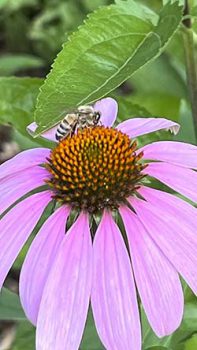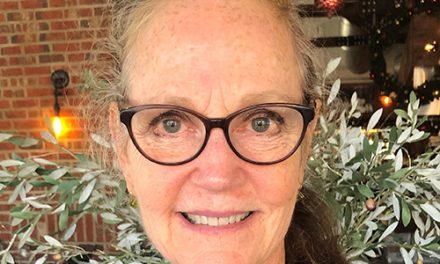
A bee at work on a cone flower.
If not for birds, bees and other pollinators, the world would starve. Those buzzing honey and bumble bees, colorful butterflies and quick-darting hummingbirds have a huge job to perform: pollinating plants that grow into the fruits and vegetables we eat and the blossoms we enjoy.
In truth, 98 percent of the food we eat – from fruits and vegetables to meat, dairy products and grains – relies on being pollinated to mature and reproduce. But to get a bountiful crop to harvest, gardeners need to feed the pollinators.
It’s easy to ensure that pollinators can survive. Even with the reduction in natural habitats, you can do your part to keep them around.
Go native, and pair flowers with vegetables
Native plants are the best for attracting pollinators. Summer perennials, like purple coneflower, cosmos, Shasta daisies, bee balm, catmint, liatris and various herbs like thyme, oregano and lavender will bring in the buzzing bees and darting hummingbirds.
Blooming shrubs like chaste trees, panicle hydrangeas and butterfly bushes nearby will encourage visitors. Sunflowers can attract birds who pick the seeds from the blossoms.
Add milkweed to your pollinator garden to provide a food source for Monarch butterflies. It’s the sole host plant for keeping these beautiful orange and black beauties prolific. The eggs develop into green, white, black and yellow plump caterpillars that feed on the plants, then spin their chrysalis into a protective shell that allows the adult butterfly to mature.
Adding colorful blooms to your vegetable gardens can ensure higher production. Bright marigolds, tall zinnias and even sunflowers can attract more pollinators to your food gardens and make it prettier. The bees, butterflies and even birds will help pollinate blossoms that will become the tomatoes, squash, beans and peppers to harvest.
Catering to pollinators
A national movement to increase habitat for pollinators has created a plethora of information about what attracts pollinators, how to create habitats and even how to become certified as a pollinator habitat.
The U.S. Department of Agriculture/Forest Service offers the following tips:
- Consider plants with a range of bloom seasons from spring through fall. Include both daytime and night-blooming species.
- Pollinators find plants more easily when planted in clumps.
- Provide a water source for pollinators.
- Do not remove dead trees or branches, which can be used for nesting or shelter.
- Avoid the use of pesticides. More than 90 percent of garden insects are beneficial.
What’s that plant?
Want to know the name of an interesting plant? Do you need to determine what’s wrong with it and how to fix it? There’s an app for that; some are free, others require a one-time download cost or an annual subscription.
If you own an iPhone, there’s a built-in app that’s free. Snap a photo of the plant, then click on the picture. Tap the photo, swipe up to see ‘Look Up – Plant’ and a lower screen provides the plant name and other info.
Google Lens, which is free, can also identify plants, among other things, and can be installed on iPhone or Android.
Check out these other apps:
Picture This – has a free or enhanced (read it costs you) version, my go-to. It can ID plants and diagnose diseases, insect damage and remedies. Several garden review services have rated it No. 1.
PlantNet – a free app for both iPhone and Android that includes GPS mapping and a search feature.
iNaturalist – a free app developed in a joint initiative with the California Academy of Sciences.
Photo: by Pamela A. Keene






